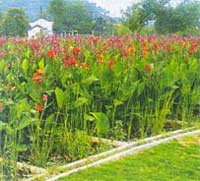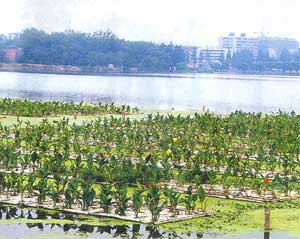Chinese flower lake cleaning method

Water flower garden filter
The flower gardens on the water make the Lake and Moon Lake - the ecological lungs of Wuhan City - look very romantic. But not only are they decorative objects, they also work to clean up the city's waste water into these lakes.
Chinese scientists have applied five integrated measures to protect the environment of the two lakes, suggesting their application to lakes in our country.
First: Using water to circulate through the filtration system is a flower garden. Specifically, water is pumped into a system of tubes with many small holes. The tubes are placed parallel to each other on a large lake but not very deep (later becoming flower gardens), in the pits filled with large and small stones. Planted in that kind of yellow and red flowers of canna family. This type of plant has long roots and is able to strongly absorb organic and inorganic substances contained in waste water. Water flowing down the hard ground will escape in one place and flow into an artificial stream before returning to the lake. This stream is beautifully designed.
It is also possible to grow a very fast growing grass and bloom very well in a certain season.
Second: Combined with the first measure, but only in the area of soil covering the spraying pipes and on that soil planted ornamental plants with deep roots to clean up the water.

Flowers on the lake
Third: Choose a corner of the lake to spread porous carpets floating on the surface with small holes in the above-mentioned flower tree and create a flower garden on the lake. Very beautiful blooming flowers and roots up to 60 cm deep should clean the lake water very quickly. Asked why not using water hyacinth, Chinese managers said that the type of duck grows too fast, occupies all the surface of the lake, there is no beautiful scenery and the boating area. Moreover, their roots are not long.
Fourth: Use a boat to drop the net and hire workers to drag to the shore of the fast-growing seaweed, filling up the water surface. This seaweed is transferred to fish feed or as fertilizer.
Fifth: Where the treated water, before flowing into a large lake, is concentrated in a small pond, treated with microbial inoculants to decompose the remaining organic matter and greatly reduce the The index of BOD, COD, NH3, NO2, NO3 . This way also solves the situation of flowering water, meaning that the micro-algae that meet many organic foods have grown too much on the water surface.
- What is dry cleaning?
- Inventing self-cleaning paint
- Chinese desert freshwater lake gradually disappears
- UAE opened the world's largest flower garden
- 10 most rare and beautiful flowers in the world
- Robot cleaning pool
- 5 'forbidden death zone' a go no return in China
- Use an antique flower vase of 860,000 USD to block objects for 36 years
- For the Sword Lake turtle to breed with Chinese turtles
- Bustling 'Tet flowers' in the Capital
- The bewildering Loch Ness monster-like creature in China
- China investigates the Eastern Devil Triangle
 'Barefoot engineer' invents a pipeless pump
'Barefoot engineer' invents a pipeless pump Process of handling dead pigs due to disease
Process of handling dead pigs due to disease Radiometer
Radiometer Warp Engine: Technology brings us closer to the speed of light
Warp Engine: Technology brings us closer to the speed of light